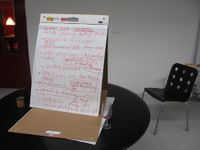Difference between revisions of "Micro to Macro Water Pollution"
| Line 62: | Line 62: | ||
=== Water Collection Protocols === | === Water Collection Protocols === | ||
| + | ---- | ||
| + | <br><br> | ||
=== Coliform Bacteria Counting === | === Coliform Bacteria Counting === | ||
Revision as of 08:29, 13 April 2016
Background Information
Hammerdirt came to the BIO-DESIGN for the REAL WORLD's Winter School with data on the macropollutants washing up on the local beaches in and around Montreux (CH). The data format conforms to international norms, and over two years, some patterns can be observed in the level of litter on the shores. The collaboration will be an exchange and complement to what is already on-going at Hammerdirt.
The presentation can be found here:How we can work together
Aims
To answer: Does the presence of macropollutants on the shores of Lac Leman correlate with micropollutants (biological, chemical, particulate, etc.) in the lake water?
Brainstorm Results
At Open Hackuarium #88, we came up with some initial ideas.
- Data Analysis
- Image analysis and machine learning to readily tabulate the macro-pollutants collected on the beach
- synching the above data with a phone application in the internationally accepted format
- Add lake existing data (lake current, meterology, etc.)
- Water collection and Analysis
- Standardizing Collection Methods
- Water chemistry testing - turbidity, pO2, pH, conductivity, temperature
- DIY free NH2
- Microparticle counting - DIY
- Heavy metal analysis DIY equipment of BIODESIGN to be more robust - or
- Make a fluorescent plate reader for higher throughput (CAUTION: still need P1 to use bioreporters here)
- antibiotic resistant bacteria (CAUTION: we cannot amplify/concentrate possible pathogens)
- Fish diseases - ask Maison de la Rivière?
- Awareness Raising - Recycling
- Recycle plastics using the extruder and use it to 3D print objects
- Biodegradation with mycelium
Collaboration Defined
The collaboration between Hammerdirt and BIO-DESIGN for the REAL WORLD as of 2016
1st stage:
- coliform bacteria counting
- easygel
- DIY version
- community bioreporter kit field version for Switzerland
- robust hardware
- easy to manipulate wetware (remove possibility of error in the protocol - including standard curve generation, etc.)
- a water multimeter
- pH, conductivity, dissolved O2, temperature
Action Plans
- Hammerdirt collects baseline and routine water samples for testing
- Research what other relevant datasets are out there and document it
Documentation and Collaboration Tools
Agree on documentation and collaboration tools
- Internal communication - hackuarium slack
- Calendar? - we have a biodesign google calendar
- Protocols - [1]?
- Electronic Lab Notebook - [2]? - a template system where people can write down what they do would be nice, should it be the same as the Data entry format where you comment on unusual procedures or events?
- Data entry and sharing - Hammerdirt github, compliance with the international standards
- Hardware design - biodesign github
Water Collection Protocols
Coliform Bacteria Counting
Coliform bacteria is an indirect indication of fecal contamination of the waters. There are several methods to distinguish coliform bacteria vs other microorganisms that may grow on an agar plate.
Easy Gel
Micrology Labs Coliscan Easygel
- Rachel orders a coliform bacteria testing medium (done)
Protocol from the Micrology Labs
DIY protocol
Automatic Colony Counter and Plate Counting
This is not a DIY gel, but ENDO agar was used for the workshops Lifepatch conducted in Indonesia: Quantification of e. coli contamination in water
From Lifepatch, we have set this up DIY automatic colony counter.
Other Methods
Biodesign has tried:
- Hack-a-Taq
- This early post has a pdf at the end summarizing techniques, including portable sensor, paper strip, etc.
Scaling
Basic calculation for cost for one time analysis:
- number of plates = number of sites x number of dilutions x number of replicates + positive control + negative control
Use glass petri-dishes for recycling - we can as Lifepatch how they set it up.
Community Bioreporter Kit for Switzerland
- Our current prototype needs to be field-ready - the final design parameters need to be discussed.
- The protocol for the bioreporter assay needs to be simplified.
Otherwise, the system for working with the bioreporters has been approved with the Swiss authorities.
Water Multi-meter
- (Art)ScienceBLR
- Student Project 2016
Relevant Links
Discard Studies publishes interesting articles on Water Pollution
- Pharmaceuticals Out of Bounds - conference coming up in 2016
- DIY Plastics Collector "Babylegs"
- Redefining pollution and action - article
Electronic Lab Notebooks
- A universal open-source Electronic Laboratory Notebook Bioinformatics 2013 29(13):1710-2. doi: 10.1093/bioinformatics/btt253
